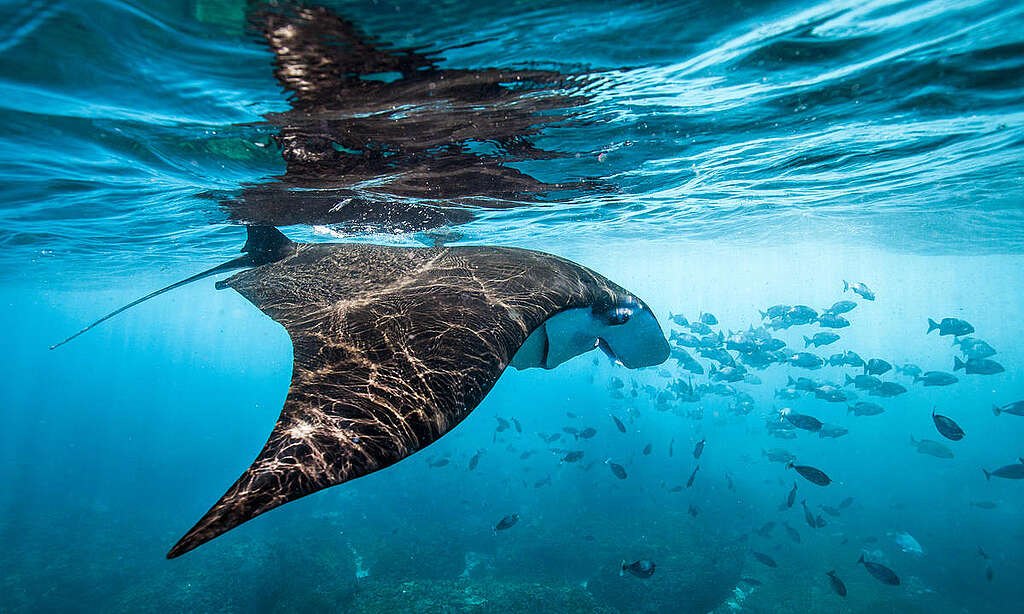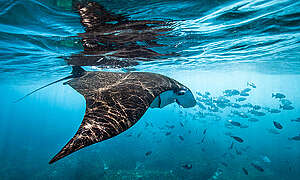In March 2023, history was made when the UN finally agreed on a new Global Ocean Treaty. This Treaty is a powerful tool that can help protect at least 30% of the oceans by 2030. Time is running out, and reaching this target will require a strong and urgent political response. This report offers clear routes to action to get across the finishing line and help the oceans thrive again.
The High Seas cover 61% of the world’s oceans and occupy 70% of the living space on our planet, including land and sea. These international waters are home to a stunning wealth of marine life and ecosystems. They are crucial to many of the key processes that sustain life on our blue planet, including mitigating climate change.
But in recent decades life in the High Seas has dwindled under the rising impact of multiple human stresses, prompting the United Nations to begin a process to reform management in international waters.
Key report findings
- The Global Ocean Treaty is one of the most important international conservation agreements in history and the first focused on conserving marine life on the High Seas.
- In this report, new analysis of rising pressures on the High Seas underlines the importance and urgency of protecting at least 30% of the oceans by 2030 using the Treaty. 11 million KM2 per year must be protected to meet the United Nations’ 30×30 target that all nations agreed in 2022. The Treaty is the only way to deliver the 30×30 target at sea.
- The oceans face large-scale threats and there is little time left to deliver 3-x3-. Swift action is needed. Governments must ratify the Global Ocean Treaty by the UN Ocean Conference in June 2025 to leave enough time to meet the 30×30 target.
- Alongside governments ratifying the Treaty, this report sets out the various institutional arrangements that must be set up. These include a Conference of Parties (COP) and a Scientific and Technical Body. A Preparatory Commission must be established, which can begin implementing the Treaty.
- Governments must also begin to develop the first ocean sanctuary proposals alongside ratification. Work on these steps must start immediately. Delay would risk the timely and full implementation of the Global Ocean Treaty and jeopardise 30×30.
- This report sets out the political process for using the Treaty to deliver Marine Protected Areas (MPAs) on the High Seas ‒ from first submitting an MPA proposal to the COP to implementing and establishing a new MPA.
- Threats to the oceans are diverse and severe, and are having wide reaching impacts on the health of the oceans. These threats include: ocean acidification, deoxygenation and warming; pollution, including plastics; shipping; the looming threat of an emerging deep sea mining industry; and industrial fishing.
- This report includes new analysis that shows the extent of High Seas industrial fishing activity over the last five years. It details the vast scale of High Seas fishing and provides a snapshot of fishing activity in areas recommended for protection under 30×30.
- Using data from Global Fishing Watch, Greenpeace International investigators estimated that High Seas fishing hours increased by around 8.5% (662,483 hours) between 2018 and 2022. In 2022, industrial fishing vessels spent a total of 8,487,894 hours fishing on the High Seas.
- Longliners, squid jiggers and trawlers were the most common gear types. Longliners made up over 3/4 of total fishing activity on the High Seas globally. These vast lines have thousands of baited hooks and can be over 100KM long. This destructive gear type results in high levels of bycatch as it hooks anything in its path.
- In the areas recommended for protection in 2019’s Greenpeace International report 30×30: A Blueprint for Ocean Protection, there were 2,938,182 fishing hours in 2022 ‒ a 22.5% (541,607 hours) increase from 2018.
- Ocean temperature levels have broken records in 2023. Heating coupled with acidification and deoxygenation is changing the chemistry of the oceans. This has vast and wide-reaching impacts on ocean ecosystems and biodiversity, as well as disrupting the vital role oceans play in regulating this planet’s temperature and climate.
- Deep sea mining poses a significant new threat to the High Seas. Many governments now support a moratorium (ban) on deep sea mining. It is vital this dangerous industry is not permitted to add yet another threat to the health of the oceans.
- Pollution, including plastics, continues to worsen. This is having devastating impacts on marine life and ecosystems. Shipping leads to chronic oil and noise pollution on the High Seas and there is always a risk of accidents and spills.
- Three high-priority sites are presented as case studies for protection under the Global Ocean Treaty. These sites are: the Sargasso Sea, Emperor Seamounts and South Tasman Sea / Lord Howe Rise. All sites are critically important in terms of biodiversity and experience severe impacts from climate change and industrial fishing. We set out the cumulative pressures on these ecologically -significant areas, then map how each can be protected under the Treaty.
- Governments urgently need to take action to protect the High Seas and deliver 30×30. The vast and ever increasing fishing activity in ecologically sensitive areas earmarked for protection makes this clear. Every year of delay, stacking pressures on the oceans grow. Consequences worsen for marine ecosystems and the billions of people who rely on healthy oceans for their food and livelihoods.

Sign our petition to call on the Australian government to urgently ratify the Global Oceans Treaty, and create a sanctuary for the South Tasman Sea and Lord Howe Rise.
Sign petition

